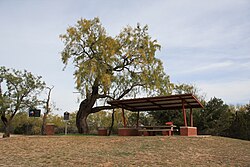Rath City, Texas | |
|---|---|
 Historical marker and rest stop at site of former Rath City | |
| Coordinates: 33°00′35″N 100°10′54″W / 33.00972°N 100.18167°W | |
| Country | |
| State | |
| County | Stonewall County, Texas |
| River | Double Mountain Fork |
| Established | 1876 |
| Founded by | Charles Rath |
| Elevation | 1,660 ft (510 m) |
| Time zone | UTC-6 (CST) |
Rath City was a frontier town that existed for fewer than five years, and is now a ghost town.[1] The town was located on the Double Mountain Fork Brazos River, 14 miles northwest of Hamlin in southern Stonewall County, Texas, United States.
History[edit]
The town was founded in 1876. Its original establishment was meant to capitalize on the buffalo trade, and it was Stonewall County's first settlement. In 1877, the town housed a store, two saloons, a dance hall, and a few tents and dugouts. The town's namesake was Charles Rath, whose store, built in 1875, was the structure around which the village grew. A declining buffalo population ended the settlement, and it was abandoned in 1880.[2][3]
Rath City and Native Americans[edit]
In February 1877, after buffalo hunter Marshall Sewell was killed by Native Americans, Rath City became a rallying point for over 500 frontiersmen. A group of 46 men left Rath City in pursuit of a Comanche war party led by Black Horse, in a campaign known as the Buffalo Hunters' War or Staked Plains War. The men pursued the Comanche to a site in present-day Lubbock. A battle ensued on March 18, 1877, at Yellow House Canyon; its results were inconclusive. The hunters returned to Rath City, thus ending one of the last Indian campaigns on the southern plains.[2][3]: 34–36
See also[edit]
- Canyon Valley, Texas
- Double Mountains (Texas)
- List of ghost towns in Texas
- Llano Estacado
- Salt Fork Brazos River
References[edit]
- ^ "Rath City (historical)". Geographic Names Information System. United States Geological Survey, United States Department of the Interior.
- ^ a b Rath City, Texas: Handbook of Texas Online, University of Texas at Austin
- ^ a b Holden, W.C. (1962). Graves, Lawrence (ed.). Indians, Spaniards, and Anglos, in A History of Lubbock. Lubbock: West Texas Museum Association. pp. 32–33.
External links[edit]
- Rath City, Texas on Ghosttowns.com
- Public domain images of the Llano Estacado and West Texas


